DOF Landscapes, Ang Thong

Feature Photograph

This weeks feature photograph not only fits our current theme of exploring depth of field (DOF) as a compositional element, but is also significant for making something out of nothing. For making an interesting and appealing photograph out of a very common subject, but in such a way where the technical’s become responsible for creating the art and the interest.
Really, you need to be looking at the 24×30” version of this image from about a meter away. It’s very difficult to really grasp the impact of many images when presented on a computer monitor, much less on a computer monitor reduced in size to fit easily in a column. Properly sizing and cropping an image to have the most effect on given media display whether it be a book cover, computer monitor, billboard or 4×6” print is a topic by itself and will be covered in a future column. However, for now look carefully at this image on your computer monitor and try to follow along with what I’m describing while looking at the big print version.
Immediately you should see a common yellow sunflower set among an uncluttered background. Looking closer the petals closest two you should appear in sharp focus as will several leaves of the plant, while others will appear soft and out of focus. Light is striking these leaves from several angles and appears to backlight all the petals.

What you can’t see on the smaller version that you might be able to see on the still restricted size crop above, is the forming of the seeds. The part closest to you remains in sharp focus showing every detail, even the small ‘hairs’ and inside the openings, and then the part furthest from you fades into the background more gradually appearing out of focus the further away you get. The opening in the center of the flower was chosen as the ideal place to cut this flower in half using DOF, half is super sharp, half fades to a pleasant blur. As your eyes move around the big print version you can clearly see all these things happening on the flower, and to varying degrees on the stalk and leaves. The background bokeh is smooth and pleasant and serves as an attractive backdrop to the main subject.
Would you have selected a different amount of DOF? Would you have defocused the background more or less? Would you have cut the DOF down the exact middle of the flower? All good questions that might vary from artist to artist, and this is after you’ve selected the proper angle from the lens, where the light hitting the flower brings out the most detail, where the sunlight backlights the petals before filtering through into sight. A very basic composition, with many variables and subsequently decisions we must make to create the vision we’re seeing in our heads as we look through the viewfinder.
Perhaps a better angle to this, is to ask yourself if you’re asking yourself these questions before photographing a simple sunflower. If you are you’ve done this before and you realize the impact even small variables will have. If you’re not, then what are you asking yourself? It’s probable most people are asking at least some of the questions, and it’s possible to need to ask more than what I listed above. If you keep an active interest in photography and constantly learn and improve, then you’ll probably find yourself asking more and more as time goes on.
In a future column we’ll use this same sunflower and examine what the image would look like had different choices been made. There really is no right or wrong when making your compositional decisions, but you can learn to more please one viewership over another. We’ll explore this at a later date.
Weekly Photo Outing
Sometimes I just get in the car and head out for the day looking forward to a nice drive, seeing new things, and taking interesting photographs. This outing was like that. Initially I was heading towards Suphanburi but then I saw a sign that said “Ang Thong” and my curiosity got the better of me. Ang Thong is an agricultural area about 90 minutes outside of Bangkok. It’s so rural its hard to believe such a modern city like Bangkok is geographically so close.
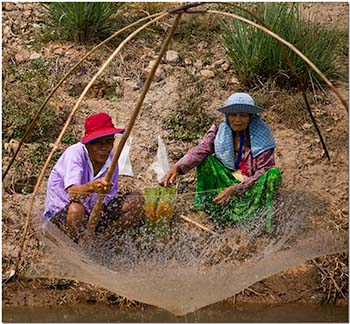
Driving in there was what appeared to be a common canal, but many people were fishing in this one. There were fishing poles, nets, basket traps and all kinds of methods for extracting fish from the canal and many seemed to be successful.
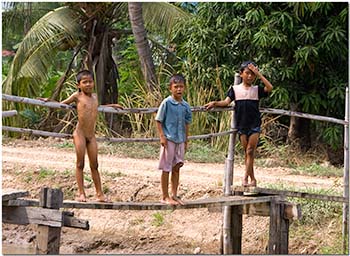
In some areas of the canal kids were jumping off docks, swimming, and generally having a great time cooling off on a hot summer day. Kids in these parts don’t really care if they’re wearing clothes or not when swimming.
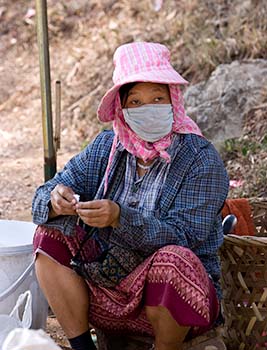
Along the roads you’ll find people preparing and selling all sorts of things. Most often this will be whatever fruit or vegetable happens to be in season. Other times someone will be making brooms or baskets from the unused parts of the crops and selling those as well. You’ll find all kinds of interesting booths to stop and look over.
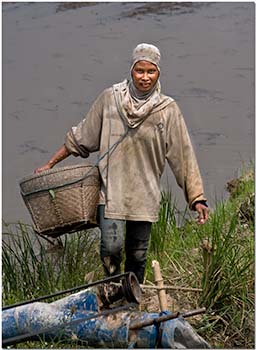
Everyone works the rice fields and it’s a full time job. Rice fields are everywhere. If you haven’t seen them before you’ll have a hard time believing the bright almost fluorescent green fields, especially right before harvest when the rice is waving in the wind.
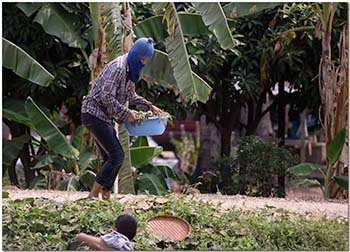
Almost everywhere you look the land has something growing on it, and people harvesting what’s being grown. No land goes unused.
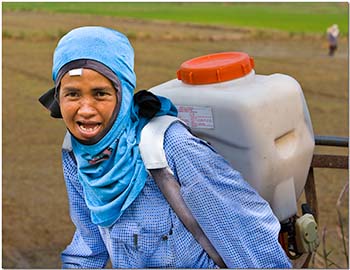
Often modern agricultural tools look out of place among the much more common traditional tools, wicker baskets, hand dug irrigation ditches, foot bridges built from nearby natural growth, and workers who wear traditional garb you might have seen 100 years ago.
Ang Thong was both delightful and educational. The entire trip took less than ten hours. We had lunch along the way, stopped many times and chatted with the locals, took many photographs, learned about rice farming, and was able to observe a traditional agricultural village as it went about its everyday business of growing food for sale in the nearby city.
Using DOF for Landscapes
Last week we discussed using depth of field (DOF) as a compositional element when composing portraits. This week we’ll be discussing using DOF as a compositional element when composing landscapes. Generally, with landscapes we want all the DOF we can get. We want everything in focus. Really, this is a simple concept so I’m going to move right past it and into the area of landscapes where we desire an extreme DOF. This is where we include a subject in the foreground which lends depth and scale to the background. It will also add another dimension to the image, giving a 3d look on a 2d medium.
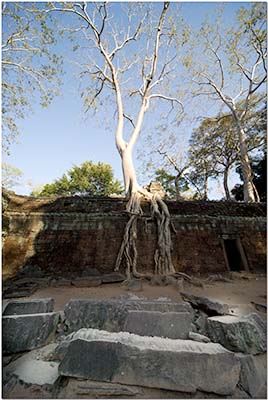
In the image above the main subject is the magnificent old tree with the exposed roots growing down the ancient temple walls. By itself an interesting image. But now add the stack of stones as a second subject in the immediate foreground and immediately you add depth and scale to the image, you can almost feel yourself standing next to the stack of stones allowing you to place yourself in the composition. This image might seem simple, until you realize it required a 12mm lens with an aperture of F11 to achieve the extreme DOF required.
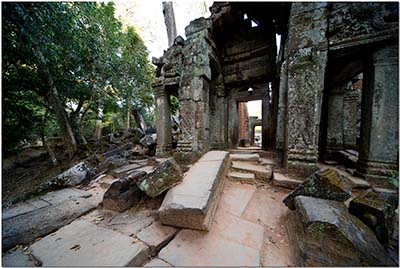
This time we did much the same thing as we did in the first image. We added compositional elements to the foreground, but this time instead of in the front and center we added them off to the side and extended the scale diagonally across the frame with first one large stone nearest, to the next largest stone a bit further out, another stone even further out, and then the trees. At the same time the main subject (the structure) starts out close on the right side, and heads away from us diagonally across the frame. Everything is in focus. This image was shot at 14mm with a F11 aperture, and every bit of the frame is in focus.
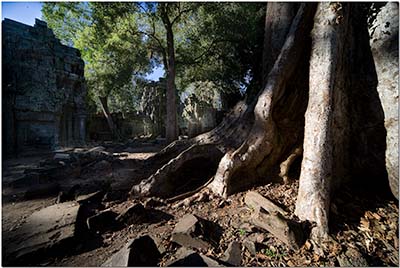
This is one of my favorites. I ate lunch beside this tree, exactly where the image makes you feel like you’re sitting. Can you clearly see the leaves and dirt in the lower right corner? How big in scale the tree is compared to the much large buildings in the background? Every bit of this frame is in focus from inches from the lens, to hundreds of meters away. This shot required me laying on the ground with the lens less than six inches from the ground, a 12mm lens, and an aperture of F11. As your eyes follow the image it starts in the lower right corner with the leaves and dirt, moves along the detail of the bark on the tree and its giant roots, moves across an open courtyard for about 50-80 meters, and then come to rest on the far structure in the far background.
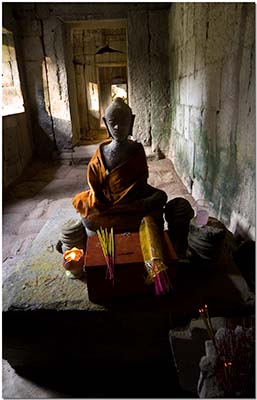
This image demonstrates how the techniques and equipment used in creating open landscapes can also be deployed inside the confines of a structure to create interesting compositions. The DOF in this image is so extreme you can clearly see from the embers in the extreme foreground, all the way through several door frames all the way down the passageway. Everything is in focus, everything lends detail, and the image gives you the illusion of actually being there, standing right in front of the Buddha and placing your own incense stick. Again, this required a 12mm lens and a F11 aperture. Because we were indoors with much less light, it also required a steady tripod, cable release, and several second long exposure.
Can you see how adding a second subject, or compositional element to the foreground helps lend scale and dimension to the background? How the extreme DOF brings both elements together? How it brings the viewer right into the scene, how it places them exactly in the composition as intended? To me, this is a much more effective technique and enjoyable image than merely another snapshot of something in the distance. This technique virtually makes the viewer involved in the image in a very important way.
Photography News of Interest
Culture clash? I find it unbelievable that an amateur photographer would be fined for taking a snapshot of a person with the poor judgment to get drunk/sick in public, but this is exactly what we had happen in Edinburgh Scotland recently. The sheriff thought the photographer was being “unchivalrous” in photographing the lush and fined him 100 pounds. No mention what the drunk lady was fined for being.. perhaps “disgusting” and publically intoxicated? Read more here.
Well, it’s official now. No more nude photo exhibits in Ethiopia! I’m sure this will ruin the plans of many, but I hope you’re not one of them.
We covered this in this column a few months back, about a wedding photographer who collected her fees from clients and then never turned over the promised photos? It appears the State Attorney General is going after the guy now. This can’t be good news for the unethical photographer, but it sure is for those of us who conduct business honestly! Read about it here.
The International Photograph Awards (IPA) are perhaps the most recognized photography awards in the world, somewhat like winning an Oscar or Emmy but for photography. Last year (2007) I was delighted to learn that a friend and associate of mine captured two top place finishes for the work he did at Thailand’s new international airport Survarnabumi, and again this year (2008) for he continued his excellence by earning two more first place finishes. I learned a lot from this man when he was here in Bangkok, many nights we’d look over the proofs and comment on what we found appealing about certain images, discussed equipment and technique, and two very different but strangely similar lives that brought two strangers, two photographers, together in a foreign land. If you’re reading this Rainer I wish you the best and I’m looking forward to your next visit! You can view the IPA results here.
Readers Submissions
No readers submissions this week. If you have anything you’d like to share please send it in for next week.
I suspect the readers submissions will be a highly anticipated section of this column and I encourage anyone with photographs and travel accounts they’d like to share to please send them to me at: QandA@Bkkimages.com
Readers Questions
BkkSteve:
I’m looking to purchase an external hard drive to use with my notebook while traveling. I see many different models and prices, is there really any significant differences between them all that I should be aware of?
Thank you for a great weekly, it is something I look forward to reading every week!
Regards;
Phil
Phil –
Yes, there are significant differences you should be aware of, but unfortunately it’s usually very difficult to tell by the provided specifications which models have the differences and which models don’t. This is why I tend to rely on reading multiple reviews on these products before forming an opinion and making a purchase.
I’ve been using external hard drives for well over two decades and like everything else in the PC world they’ve progressed very far. You mention use with your notebook and traveling so lets stick to discussing what’s best for this application. Without a doubt the most appropriate “type” of external drive would be the USB powered genre which is very small in size, uses little power, and can be very rugged which is perfect for traveling. USB powered external drives are many, which ones should you consider buying?
After owning nearly 20 of USB powered drives and using them on a variety of computers from PC’s to Mac’s to notebooks, and a variety of operating systems including XP and Vista both x32 and x64, I’ve noticed that very few of these work troublefree with all of these. What works great on XP might not work at all on Vista, and one which works flawlessly on Vista might have big problems even being recognized in XP. Why? These drives are nothing more than enclosures for the exact same type of hard drive your laptop uses, a 2.5” mechanical drive, which are controlled by a “chipset” of various manufacture. The chipsets are where the problems begin. Some are old and work fine with older operating systems but not new, some are new and didn’t take into account older operating systems, and most of these choices are driven by price. You can easily pick up a USB drive enclosure at Panthip for 200-300 baht which will accept the hard drive from your old laptop and put together a very inexpensive USB powered hard drive, and I recommend doing this if you have an unused drive laying around. But, depending on the vintage of the enclosures chipset and your particular operating system, you might meet with instant success, or you might have to try a different enclosure.
The big companies like Seagate, Western Digital, Iomega, and a few others offers their own brands of USB powered drives. After reading many reviews and trying several models across all the different platforms I can say without reservation that Western Digital’s “Passport”
is my number one choice and is now what I use exclusively. My second choice would be Iomega. These are small tough drives, they instantly self-install and work correctly with any computer type or OS I’ve used them with (see list above), they use
very little power, and they’re very fast compared to the competition. The last 320gig model I purchased cost $129 USD. Shop around for good prices.
Besides compatibility there are some other features the better drives offer:
- The use of just one USB connector vs. a two connector cable as was standard until recently. This is possible because the newest drives consume much less power than drives on the market even a year ago.
- They consume significantly less power. This is important when running off the battery of your laptop.
- They are designed for rugged use and incorporate shock zones and self parking heads.
- Included software makes backups easy, compresses data so you can fit more on the drive, and other various free utilities.
- Can be very fast compared to the others.
So you can see there really are some differences to consider. Personally, I think the small 5% or less price differences between the very best, and the most economical, just aren’t worth the difference of what you get.
I hope this helps
Steve
Please submit your questions to QandA@Bkkimages.com All questions will be answered and most will show up in the weekly column.
A Snapshot of Bangkok Images Week in Review
Very slow week. One two day workshop concentrating on available light portraiture with the final day showing the differences when bringing in a portable light source. These are the skills you need to make excellent images of your significant other in hotel rooms, balconies, beaches, and the more personal areas of your travels.
Mirrored Blog
I haven’t had time to sort out my blog issue yet, but I hope to get to it week after next and to be able to bring you more of my archived blogs.



